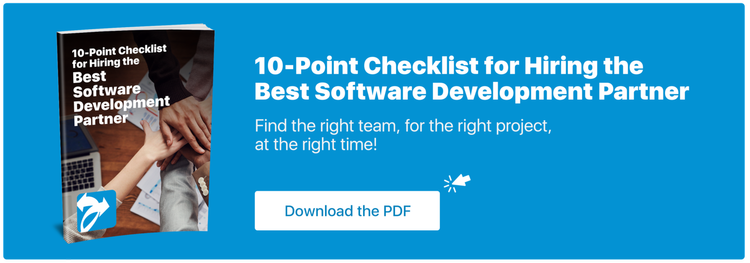Every startup will be anxious to get their product on the market as fast as possible. Getting out there will give you healthy exposure and show you how you’ll need to maneuver to succeed. Additionally, you want to get ahead of the competition and promote/develop based on experience. This is crucial but takes time, and if you want to know how to be as efficient as possible during that time, you’ve come to the right place.
When it comes to hiring software developers as a startup, there is no shortage of routes one can take, but realistically, an outside development team is your best bet. The reason being is that while the external team is taking on the project, the business can focus on planning, marketing, and promotion. Getting your name out and dropping the reel into the market's water is just as important as having a product worth buying, otherwise, you’re just fishing in the desert. With that being said, let's get into the meat and potatoes of how you can hire a team of developers:
Difficulties of searching today
It’s only fitting that you’re aware of the obstacles that go into recruiting software developers in this day and age before you begin scouting. Hiring developers is an unavoidable task for start-ups since new businesses will likely not have an experienced team from the get-go. Building a team of developers involves finding and adding members which typically comes with its own batch of challenges. Here are three general speed bumps you can expect:
Shortage of local talent: For companies, there are many beneficial aspects when it comes to hiring locally since they’re more accessible than, say, working with someone in a different timezone. Unfortunately, talent shortages are very prominent. According to Gartner, talent shortages account for over 60% of the barriers to adopting new technologies. Surprisingly, this is well ahead of costs and security measures. This fact impacts the biggest and smallest companies, which means start-ups are certainly not exempt.
Retaining talent: In cases where a startup has secured highly experienced and skilled software developers, there is no certainty that they will retain them. One of the biggest factors in this issue is that larger-scale companies are facing the same talent shortage as everyone else. This means they typically have more to offer in terms of perks and compensation than what a startup could offer to talented programmers.
Managing the budget: When a new company is hiring in-house, they will have to be very mindful of what finances will be allocated to taxes, onboarding, social security, equipment, etc. In a lot of cases, these costs add up to something new businesses simply cannot afford. In this case, businesses find software development outsourcing companies to be far more beneficial.
How outsourcing can benefit you
All hope is not lost when it comes to hiring developers in 2022. Some outsourcing service providers have identified the challenge and built an approach to make it work. Here are just a few of the benefits that come from the outsourcing model:
Big talent pool: Going the outsourcing route opens up companies' access to all sorts of technology specialists, niche market experts, and developmental expertise. Additionally, software development outsourcing businesses have teams and talent to cover a very diverse range of IT needs (Cloud Computing, DevOps, UI/UX design, etc).
Budget-friendly: Recall that one of the challenges with hiring in-house developers is having the incentives to offer associated with living and compensation. By outsourcing, companies reduce costs significantly since they are handing their project over to a company responsible for their employees as well as your needs. This is especially helpful when it comes to taking the arrangements for workspaces and equipment off your plate.
Scalability and flexibility: Outsourcing services are usually very flexible and accommodative. Team sizes can be maneuvered to fit the needs of the project by bringing in the right talent and number of individuals for different tasks.
At this point, we’ve established where the hiccups are in hiring a development team and how to avoid them. Ultimately, every startup wants to put itself in the best possible position to succeed down the road, and that starts with identifying goals. New businesses will then want their projects built around these goals which is why experienced developers are so valuable to startups. With that being said, here is the step-by-step process for startups hiring software developers:
Step 1: Define your project’s goals and the requirements of your product
Before you even pick up the phone looking for developers, you need to identify the scope of your project and outline it clearly. Get specific, and lay out the goals and requirements vividly, as well as business and technical specifications.
Figure out who’s going to be in charge of the team— you’ll need project managers for your end, the vendor, or even a solo project manager. A major priority must be finding someone to take care of UI/UX design unless you already have that arranged. Key tip: Having already built a prototype makes the transfer of design to the developers far easier.
Lastly, keep the deadline on the front burner to ensure every process can be ready in time. This is non-negotiable for projects in a startup. With everything put together, your list should look something like this:
Requirements
Project scope outlined
UI/UX design ready
Features are clear and categorized
Allocate management
Budget
Timeline
Find developers
Once this is complete, you can move on to your search for developers.
Step 2: Outline communication standards
After defining your requirements, you’ll need to understand how your partnership with the software development company is going to flow. In most cases, service providers will have plenty of options for cooperation so that you can decide which best fits your requirements.
If you’re more so in the market for a team of software specialists, then the service provider can assign a whole team of IT specialists who are experts with your requirements. Typically this will include a project manager, UI/UX designers, front and back-end developers, and more. In most cases, these teams operate according to the time and material your project needs.
Ultimately, the startup will want to be incredibly transparent with developers to ensure every necessary measure is taken.
Step 3: Think about where the outsourcing company is located
Outsourcing companies exist all over the world, which can make it easy to get lost when trying to find the best one for you. You’ll want to shop around and think about the potential communication barriers (eg. time zone or language).
The United States alone accounts for over 300,000 outsourced jobs annually, contributing over $60 billion to the $92 billion industry. Still, Canada is a primary destination for American companies looking to outsource nearshore.
The ISU Core
The ISU Core is a foundation platform that can save you up to 70% of implementation costs, and you own all the source code. The best part is our pre-built features like Intelligent Dashboards, Emailing Capabilities, Secure Authentication, Simple User Interface, and much more. It’s also mobile, web, and desktop ready. Your solution can be up and running in just days.
The Takeaway
Hiring your development team is a critical stepping stone for a startup. As you’ve hopefully grasped by now, this is not something to be taken lightly as it can make or break your success as a company. You’ll want to have dedicated plenty of critical thinking time to the project and its scope.
When all is put together, the last piece is choosing whether you want an in-house team or a custom software development company like ISU Corp. The decision is going to be unique to your business and what you think is best based on the scope you’ve created.
Written By Ben Brown
—
ISU Corp is an award-winning software development company, with over 17 years of experience in multiple industries, providing cost-effective custom software development, technology management, and IT outsourcing.
Our unique owners’ mindset reduces development costs and fast-tracks timelines. We help craft the specifications of your project based on your company's needs, to produce the best ROI. Find out why startups, all the way to fortune 500 companies like General Electric, Heinz, and many others have trusted us with their projects. Contact us here.

















